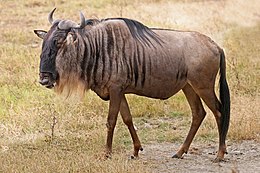Wildebeest: Difference between revisions
m Reverted edits by 66.119.31.10 (talk) to last version by Kwamikagami |
|||
| Line 32: | Line 32: | ||
==References== |
==References== |
||
<references /> |
<references /> |
||
ghfgh hey baby |
|||
==External links== |
==External links== |
||
Revision as of 15:47, 5 October 2010
| Wildebeest | |
|---|---|

| |
| Blue Wildebeest, Ngorongoro Crater, Tanzania | |
| Scientific classification | |
| Kingdom: | |
| Phylum: | |
| Subphylum: | |
| Class: | |
| Order: | |
| Family: | |
| Subfamily: | |
| Genus: | Connochaetes Lichtenstein, 1812
|
| Species | |
|
Connochaetes gnou – black wildebeest | |
The wildebeest (plural wildebeest, wildebeests or wildebai), also called the gnu (Template:Pron-en[1] noo or /ˈnjuː/[2] new), is an antelope of the genus Connochaetes. It is a hooved (ungulate) mammal. Wildebeest is Dutch for "wild beast" or "wild cow" in Afrikaans (bees = cow), while Connochaetes derives from the Greek words konnos ("beard") and khaite ("flowing hair").[3]
Connochaetes includes two species, both native to Africa: the black wildebeest, or white-tailed gnu (C. gnou), and the blue wildebeest, or brindled gnu (C. taurinus). Gnus belong to the family Bovidae, which includes antelopes, cattle, goats, and other even-toed horned ungulates.
A full grown wildebeest can be 4 ft 2 in (1.27 m) to 4 ft 10 in (1.47 m) at the shoulder and weigh 265–600 lb (120–272 kg). They inhabit the plains and open woodlands of Africa, especially the Serengeti National Park, a UNESCO World Heritage Site in Tanzania, Masai Mara Game Reserve in Kenya and Liuwa Plain National Park in Zambia. Wildebeest can live more than 30 years.
Wildebeest are known for their annual migration to new pastures. Many documentaries feature wildebeest crossing rivers, or being eaten by crocodiles or drowning in the attempt. Although it is assumed that this migration is a frenzy and that the wildebeest cross blindly, recent research has shown that a herd of gnu possesses what is known as a "swarm intelligence", whereby the animals systematically explore and overcome the obstacle as one.[4]
The major predators that prey on wildebeest are lions, hyenas, cheetahs, leopards, and crocodiles, who seem to favor the wildebeest. However, wildebeest are very strong and can inflict considerable injury to even a lion. Wildebeest have an apparent maximum running speed of around 64 km/h (40 mph).[citation needed] The primary defensive tactic is herding, where the young animals are protected by the older larger ones while the herd runs as a group. Typically the predators attempt to cut out a young or ill animal and attack without having to worry about the herd. Wildebeest have developed some additional sophisticated cooperative behavior and scientists are unsure how much is learned behaviorally and how much is hard wired into the DNA of the animal. For example, at night the animals will take turns sleeping while others stand guard against a night attack by invading predators.
References
- ^ "gnu". Oxford English Dictionary (Online ed.). Oxford University Press. (Subscription or participating institution membership required.)
- ^ Gnu Answers.com
- ^ Comparative Placentation: Wildebeest, Gnu
- ^ "Hunting Wildebeest". Retrieved 13 September 2010.
ghfgh hey baby
